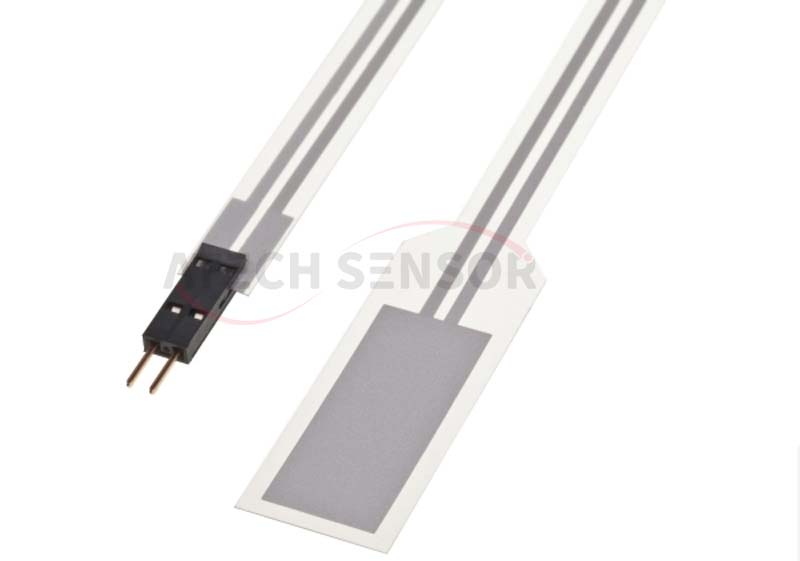Piezoelectric film sensor is a sensor that uses the piezoelectric effect to convert mechanical energy into electrical energy. It is suitable for life signal monitoring on the surface of human skin or implanted in the human body.

1.Working principle
When you stretch or bend a piece of piezoelectric polyvinylidene fluoride PVDF polymer film (piezoelectric film), an electrical signal (charge or voltage) will be generated between the upper and lower electrode surfaces of the film, and it will be proportional to the deformation of stretching or bending. General piezoelectric materials are sensitive to pressure, but for piezoelectric films, when a small force is applied in the longitudinal direction, a large stress will be generated in the lateral direction, while if the same force is applied to a large area of the film, the stress generated will be much smaller. Therefore, piezoelectric films are very sensitive to dynamic stress, and the typical sensitivity of 28μm thick PVDF is 10~15mV/microstrain (parts per million change in length).
The term 'dynamic stress' is used because the charge generated by deformation is lost from the circuit connected to the film, so piezoelectric film cannot detect static stress. This is actually an advantage when it is necessary to detect different levels of pre-stress. The film only senses the change in stress, and the lowest response frequency can be as low as 0.1Hz.
2.Application
Contact Sensor
By utilizing the dynamic strain gauge characteristics of piezoelectric film, the piezoelectric film can be easily fixed directly on the human skin (such as the inside of the wrist). The product model 1001777 of the Precision Electronics-American MEAS sensor is a universal sensor with pressure-sensitive glue coated on one side of the sensor. However, this glue has not been certified for biocompatibility. In short-term tests, 3M9842 (polyurethane tape) can be fixed on the skin, and then the piezoelectric film sensor can be attached to the 3M tape.
The reason why piezoelectric film can detect very small physical signals and can sense large-scale activities is that the piezoelectric response of PVDF film is linear over a very large dynamic range (about 14 orders of magnitude). In most cases, as long as the bandwidth can clearly distinguish the target signal from the noise, the small target signal can be collected by the filter.
Similar sensors have been used in sleep disorder research to detect movement of the chest, leg, eye muscles and skin. In addition, sensors can be used to monitor the effect of anesthesia by detecting how muscles (such as the muscles between the thumb and index finger) respond to electric shocks (neuromuscular transmission).
acceleration sensor
Minisense100 is a standard product of Precision Electronics. It adopts a cantilever beam design, with one end clamped by a rigid PCB board with connecting pins and the other end equipped with a mass block.
The mass block allows the sensor to react consistently when it is vibrated. The mass block 'remains still' while the membrane part deforms, resulting in a very high voltage sensitivity (about 1V/g). Other life sign sensors are derived from this component, such as smart badges (with built-in RF telemetry) worn by staff or patients. The wearer's signal is collected in stages to determine their location and track their status. When the sensor senses that the badge has been removed, it will set the badge to sleep; if the sensor senses movement of any part of the body, muscle tremors, or even pulse vibrations, it will wake up the badge.
Auscultation
Many electronic stethoscopes use piezoelectric film as a sensor element because of its durability, high sensitivity and wide bandwidth. In this application, the sensor element is usually encapsulated in a traditional metal stethoscope head because the sensor needs to form a "force" with the body. Once the dynamic pressure signal is converted into an electrical signal, it can be selectively filtered or amplified, played back as an audio signal, used with more complex calculation methods to determine the specific condition, or transmitted to a remote base station for further analysis and storage.
Sensor Group
A composite acoustic sensor can monitor multiple points at the same time. The sensor is attached to the skin surface with a vacuum cover. The collected signals are processed and converted into sound "images", so that the airflow in the trachea and lungs can be imaged like a cartoon. Any foreign objects and abnormalities are clearly visible in these images. This method is more reliable and safer than X-rays.
Hospital bed monitoring
Both piezoelectric films and piezoelectric cables can be installed on the mattress to detect the patient's heartbeat, breathing and body movement. The monitoring bed alarm system installs a set of sensors between the mattress and the sheets. When the patient sits or lies on the monitoring bed, the sensors can accurately measure and collect the patient's vital signs through the clothes and sheets. The flexible switch is used to collect static signals, and all the patient's dynamic signals are collected by the piezoelectric film and converted into corresponding electrical signals, which are displayed on the monitor beside the bed. The system can alarm in advance when the patient's heart rate and breathing rate are abnormal, or when the patient gets out of bed without permission. All this is done by sensors without direct contact with the patient.
Baby breathing monitor
Clip the monitor to the diaper close to the baby's waist to monitor the baby's heartbeat. The piezoelectric film is in direct contact with the abdominal skin. If the baby is not detected to be moving within the set time, the vibration buzzer will be activated, gently moving the baby to stimulate its breathing. If the baby still does not respond within a period of time, the alarm will be activated.
3.Features
Piezo film is thin, lightweight, very flexible, and can operate passively, making it a popular choice for medical sensors, especially when it comes to detecting subtle signals. Obviously, the material is particularly useful when power is limited (in some configurations, it can even generate small amounts of energy). And piezo film is extremely durable, withstanding millions of bends and vibrations.

